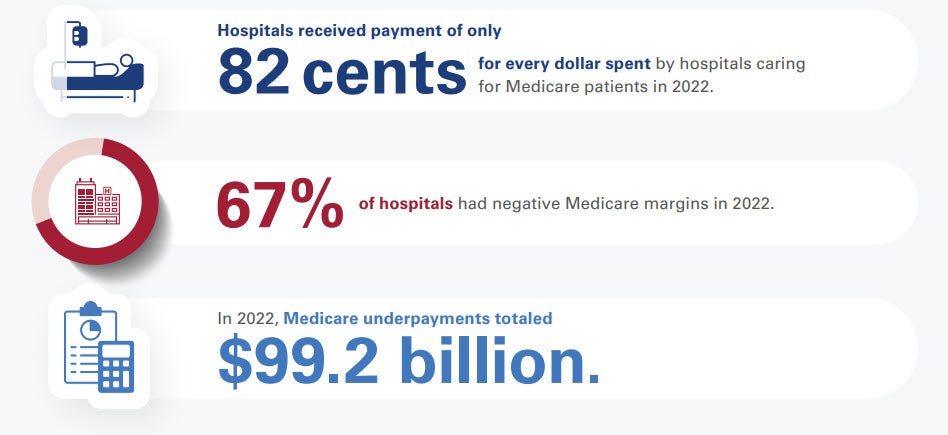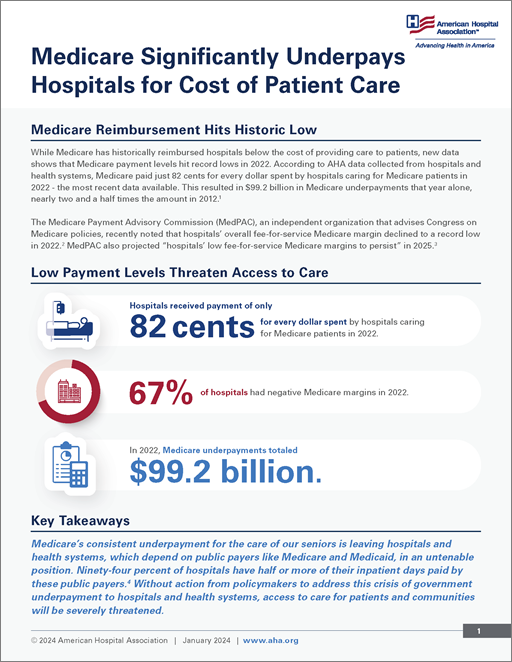Infographic: Medicare Significantly Underpays Hospitals for Cost of Patient Care
Medicare Reimbursement Hits Historic Low
While Medicare has historically reimbursed hospitals below the cost of providing care to patients, new data shows that Medicare payment levels hit record lows in 2022. According to AHA data collected from hospitals and health systems, Medicare paid just 82 cents for every dollar spent by hospitals caring for Medicare patients in 2022 - the most recent data available. This resulted in $99.2 billion in Medicare underpayments that year alone, nearly two and a half times the amount in 2012.1
The Medicare Payment Advisory Commission (MedPAC), an independent organization that advises Congress on Medicare policies, recently noted that hospitals’ overall fee-for-service Medicare margin declined to a record low in 2022.2 MedPAC also projected “hospitals’ low fee-for-service Medicare margins to persist” in 2025.3 Recognizing the dire financial situations hospitals face, the Commission in January 2024 voted to recommend to Congress a record high payment update at current law plus 1.5% for hospitals in FY 2025.
Low Payment Levels Threaten Access to Care

Key Takeaways
Medicare’s consistent underpayment for the care of our seniors is leaving hospitals and health systems, which depend on public payers like Medicare and Medicaid, in an untenable position. Ninety-four percent of hospitals have half or more of their inpatient days paid by these public payers.4 Without action from policymakers to address this crisis of government underpayment to hospitals and health systems, access to care for patients and communities will be severely threatened.
Data Notes
Defining Underpayment
Underpayment is the difference between the costs incurred and the reimbursement received for delivering care to patients. Underpayment occurs when the payment received is less than the costs of providing care, i.e., the amount paid by hospitals for the personnel, technology and other goods and services required to provide hospital care is more than the amount paid to them by Medicare for providing that care. Underpayment is not the same as a contractual allowance, which is the difference between hospital charges and government program payments.
Calculating Underpayment
Payments received by hospitals for Medicare services are reported for each hospital in the AHA Annual Survey.5 Hospitals also report their gross charges for Medicare services provided. Gross charges for these services are then translated into costs. This is done by multiplying each hospital’s gross charges by each hospital’s overall cost-to-charge ratio, which is the ratio of a hospital’s costs (total expenses exclusive of bad debt) to its charges (gross patient and other operating revenue).
- Payment = Amount Received
- Cost-to-charge Ratio = (Total Expenses Exclusive of Bad Debt) / (Gross Patient Revenue + Other Operating Revenue)
- Costs = Gross Charges x Cost-to-Charge Ratio
The resulting payment and cost figures are aggregated across all hospitals for Medicare. Payments are then compared to costs.
- Underpayment occurs when aggregate payments are less than costs.
Endnotes
- AHA Annual Survey of Hospitals, 2012-2022
- https://www.medpac.gov/wp-content/uploads/2023/03/Hospital-Dec-2023-SEC.pdf
- https://www.medpac.gov/wp-content/uploads/2023/03/December-2023-meeting-transcript.pdf
- https://www.aha.org/fact-sheets/2022-05-25-fact-sheet-majority-hospital-payments-dependent-medicare-or-medicaid
- Medicare payments include all applicable payment adjustments (Disproportionate Share, Indirect Medical Education, etc.). Payments include both fee-for-service and managed care payments.


